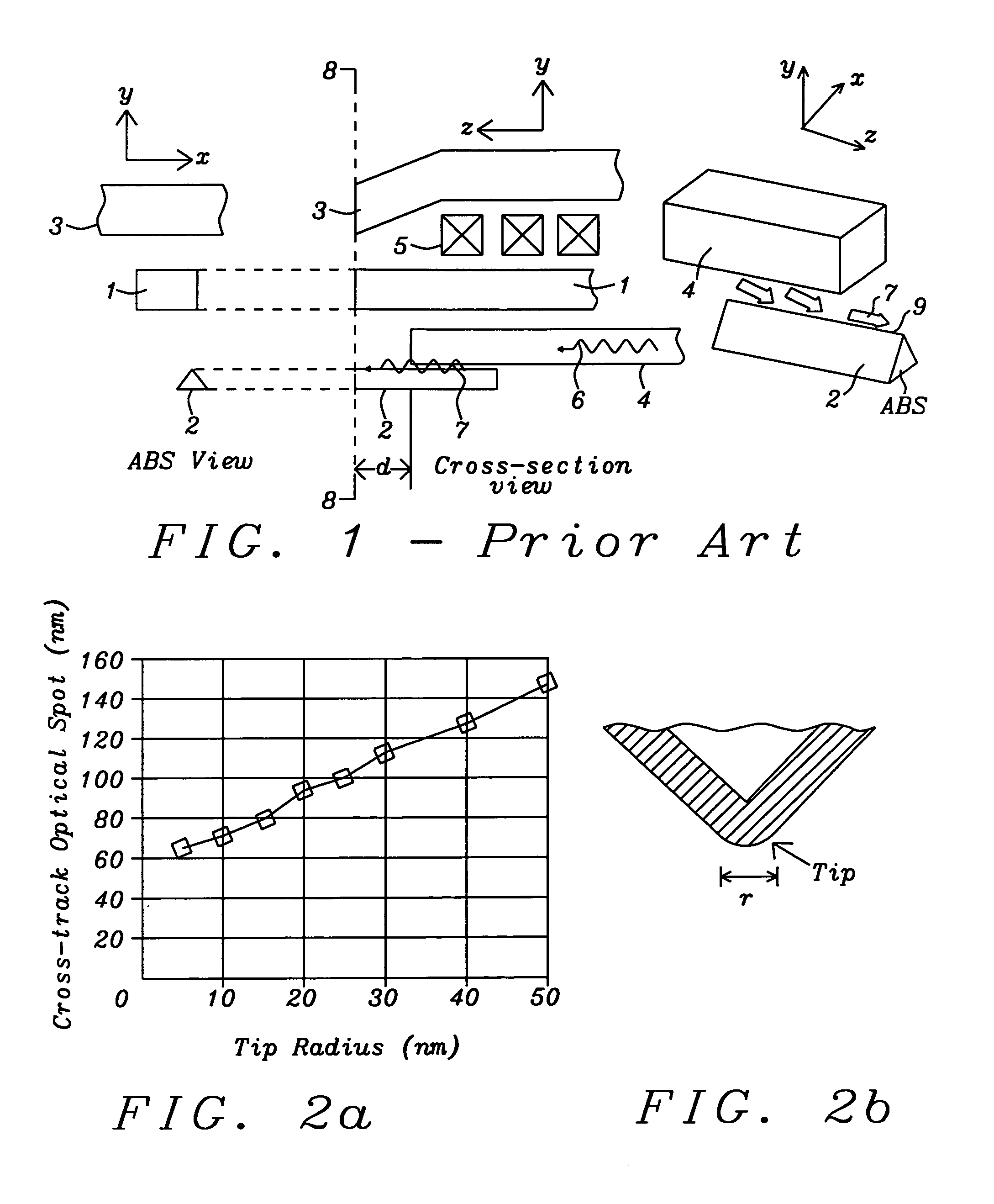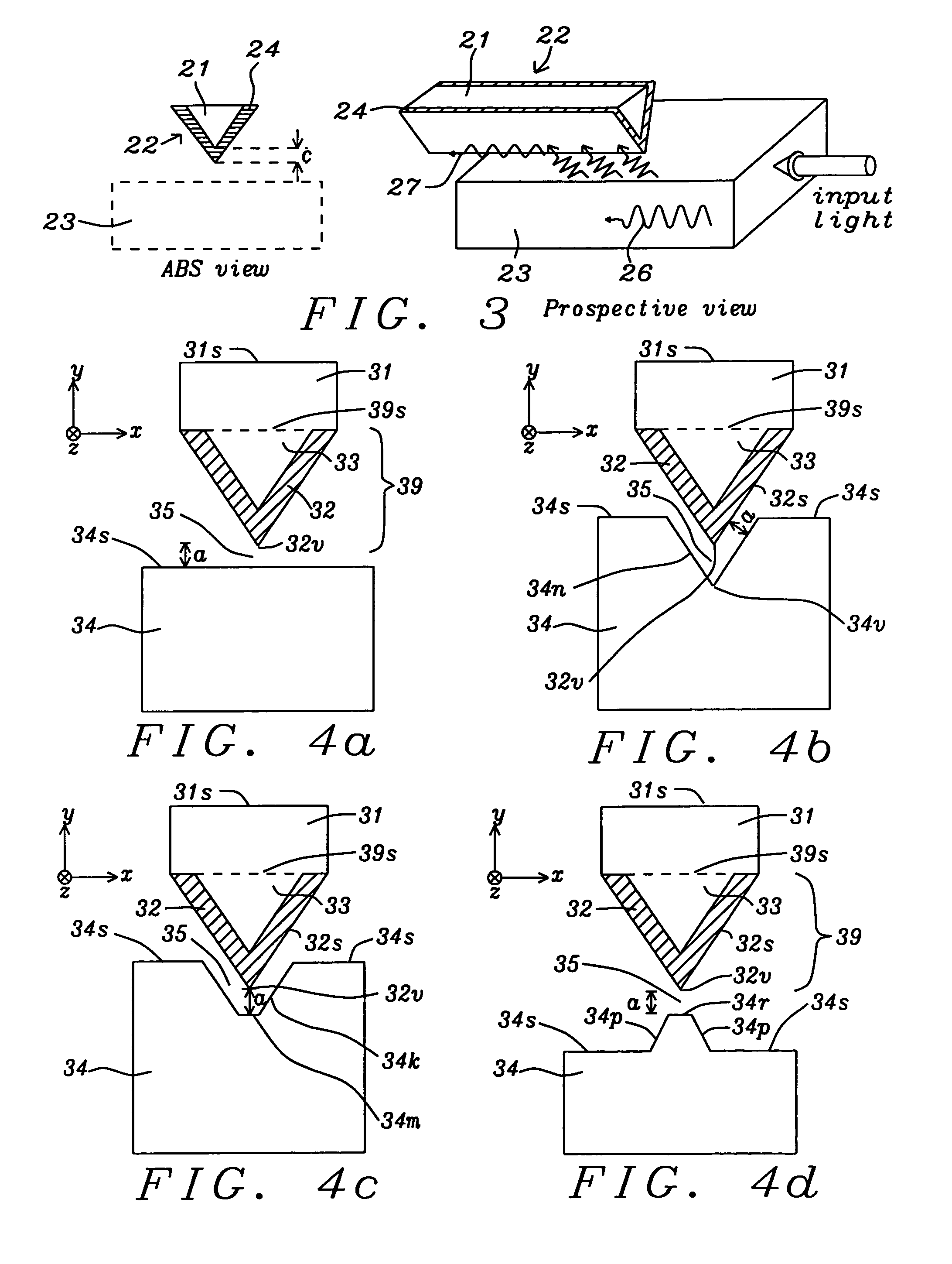Plasmon shield to shape and reduce optical spot
a plasmon shield and optical spot technology, applied in the field of magnetic read/write heads, can solve the problems of difficult to obtain a spot size less than 50 nm, difficult to fabricate a sharp tip with a 5 nm tip radius, and difficult to achieve alignment, etc., to achieve the effect of reducing the optical spot siz
- Summary
- Abstract
- Description
- Claims
- Application Information
AI Technical Summary
Benefits of technology
Problems solved by technology
Method used
Image
Examples
first embodiment
[0038]Referring to FIG. 4a, plasmon shield 34 has a surface 34s that is essentially parallel to trailing side 31s and faces vertex 32v according to one embodiment of the present invention. There is a dielectric layer (not shown) adjoining EPG 32 and planar surface 34s that separates the plasmon shield 34 from vertex 32v. The space (gap) 35 between the substantially planar surface 34s and vertex 32v has a preferred dimension a from 5 to 50 nm and may be tuned to achieve the desired optical spot size and shape on the magnetic medium (not shown). If the gap distance is 32v but is undesirably squeezed off to the sides of the tip. For gap distances >50 nm, the capability and advantage of the plasmon shield 34 to reduce the optical spot size is substantially lost. Note that the topography of surface 34s may be modified to optimize the optical spot shape. However, the first embodiment offers an advantage in terms of ease of manufacture.
[0039]In an alternative embodiment shown in FIG. 4b, a...
third embodiment
[0040]Referring to FIG. 4c, a third embodiment is depicted wherein the trench described in the previous embodiment may be modified to have a trapezoidal shape. In this case, a portion of plasmon shield 34 opposite vertex 32v is removed to form a surface 34s that is interrupted by a trench with two sloped sidewalls 34k that connect to a bottom trench section 34m which is essentially parallel to surface 34s in a z-axis direction. In one aspect, sidewalls 34k may be substantially parallel to sides 32s of EPG 32 and there is a gap distance a between vertex 32v and bottom 34m. Gap 35 as in previous embodiments is filled with a dielectric layer (not shown).
[0041]The dielectric gap 35 between EPG 32 and plasmon shield 34 may be tuned in terms of size for the desired optical spot shape in order to have a straight magnetic transition when aligning the magnetic field, and for the desired optical spot size reduction depending on tip radius. The present invention anticipates that the dielectric...
fourth embodiment
[0048]FIG. 5d is a plasmon shield / leading shield design that represents a modification of FIG. 4d wherein the leading shield 36 adjoins a section of the plasmon shield 34 opposite surface 34s. Preferably, the plasmon shield conforms to a top surface of leading shield 36 that includes surface 36s, sides 36p, and side 36r thereby providing a so-called convex shaped design for the plasmon shield and adjoining leading shield. Each of the two top surface sections 34p is substantially parallel to an underlying side 36p, and side 34r is aligned above surface section 36r in a y-axis direction. Top surface sections 36s of leading shield 36 are parallel to surface 34s and connect with side 36r through a side 36p. As a result, sides 36r, 36p form a protrusion on leading shield 36 wherein the side 36p is aligned parallel to vertex 32v in a z-axis direction, and below vertex 32v in a down-track direction along the y-axis.
PUM
| Property | Measurement | Unit |
|---|---|---|
| size | aaaaa | aaaaa |
| size | aaaaa | aaaaa |
| size | aaaaa | aaaaa |
Abstract
Description
Claims
Application Information
 Login to View More
Login to View More - R&D
- Intellectual Property
- Life Sciences
- Materials
- Tech Scout
- Unparalleled Data Quality
- Higher Quality Content
- 60% Fewer Hallucinations
Browse by: Latest US Patents, China's latest patents, Technical Efficacy Thesaurus, Application Domain, Technology Topic, Popular Technical Reports.
© 2025 PatSnap. All rights reserved.Legal|Privacy policy|Modern Slavery Act Transparency Statement|Sitemap|About US| Contact US: help@patsnap.com



